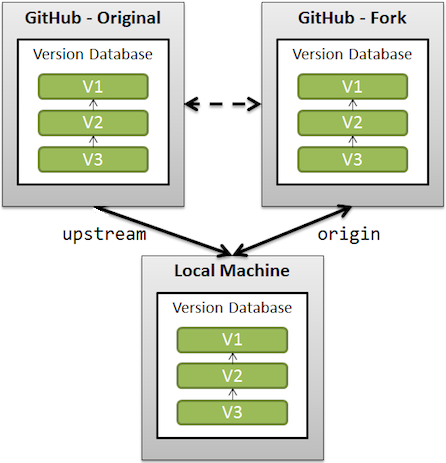GitHub中origin和upstream的区别
Fork,本身并不是git工具中的一个命令,也不是对git的扩展,它是在GitHub上的概念,是另一种clone方式——在服务器端的clone。
而我们通常意义上的clone,是将远程repo 复制一份到本地。
当你从GitHub上 clone 一个 repo 到本地时,除非你已明确声明是这个repo的contributor,否则你是不能向其pull request的,此时,该远程的repo对于本地repo来说,就是upstream。
当你从GitHub上 fork 一个 repo 之后,再 clone forked repo 到本地,你就可以任意向其pull request,此时,远程的 repo 就是 origin。

下面一段是来自 GitHub pages 的解释:
When a repo is cloned, it has a default remote called origin that points to your fork on GitHub, not the original repo it was forked from.
To keep track of the original repo, you need to add another remote named upstream
git remote add upstream git://github.com/user/repo_name.git
总结下来:
1. 如果是 upstream repo,你只可以拉取最新代码(即 git fetch ),从而保证你本地的仓库与源仓库同步
2. 如果是 origin repo,就是你自己的repo(自己创建的,或者 fork 的项目)你可以做 任何推拉操作(pull and push)
3. 你可以通过 pull request 向 upstream repo 贡献代码
Referenced by http://stackoverflow.com/questions/6286571/git-fork-is-git-clone
In terms of source control, you're "downstream" when you copy (clone, checkout, etc) from a repository. Information flowed "downstream" to you.
When you make changes, you usually want to send them back "upstream" so they make it into that repository so that everyone pulling from the same source is working with all the same changes. This is mostly a social issue of how everyone can coordinate their work rather than a technical requirement of source control. You want to get your changes into the main project so you're not tracking divergent lines of development.
Sometimes you'll read about package or release managers (the people, not the tool) talking about submitting changes to "upstream". That usually means they had to adjust the original sources so they could create a package for their system. They don't want to keep making those changes, so if they send them "upstream" to the original source, they shouldn't have to deal with the same issue in the next release.
http://stackoverflow.com/questions/2739376/definition-of-downstream-and-upstream/2749166#2749166
What is the difference between origin and upstream in github?
When a git branch -a command is done, some branches have a prefix of origin(remotes/origin/..) while others have a prefix of upstream (remotes/upstream/..).
================
This should be understood in the context of GitHub forks (where you fork a GitHub repo at GitHub before cloning that fork locally)
- upstream generally refers to the original repo that you have forked
(see also "Definition of “downstream” and “upstream”" for more on upstream term) - origin is your fork: your own repo on GitHub, clone of the original repo of GitHub
From the GitHub page:
When a repo is cloned, it has a default remote called origin that points to your fork on GitHub, not the original repo it was forked from.
To keep track of the original repo, you need to add another remote named upstream
git remote add upstream git://github.com/user/repo.git
You will use upstream to fetch from the original repo (in order to keep your local copy in sync with the project you want to contribute to).
You will use origin to pull and push since you can contribute to your own repo.
You will contribute back to the upstream repo by making a pull request.



【推荐】国内首个AI IDE,深度理解中文开发场景,立即下载体验Trae
【推荐】编程新体验,更懂你的AI,立即体验豆包MarsCode编程助手
【推荐】抖音旗下AI助手豆包,你的智能百科全书,全免费不限次数
【推荐】轻量又高性能的 SSH 工具 IShell:AI 加持,快人一步
· .NET Core 中如何实现缓存的预热?
· 从 HTTP 原因短语缺失研究 HTTP/2 和 HTTP/3 的设计差异
· AI与.NET技术实操系列:向量存储与相似性搜索在 .NET 中的实现
· 基于Microsoft.Extensions.AI核心库实现RAG应用
· Linux系列:如何用heaptrack跟踪.NET程序的非托管内存泄露
· TypeScript + Deepseek 打造卜卦网站:技术与玄学的结合
· 阿里巴巴 QwQ-32B真的超越了 DeepSeek R-1吗?
· 【译】Visual Studio 中新的强大生产力特性
· 张高兴的大模型开发实战:(一)使用 Selenium 进行网页爬虫
· 【设计模式】告别冗长if-else语句:使用策略模式优化代码结构
2020-10-10 Helm3与Helm2对比
2016-10-10 删除docker私有库镜像
2014-10-10 HDU2426:Interesting Housing Problem(还没过,貌似入门题)